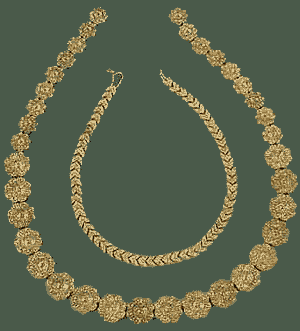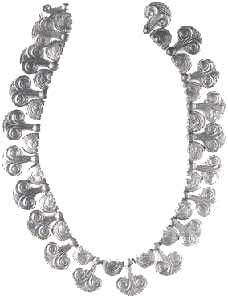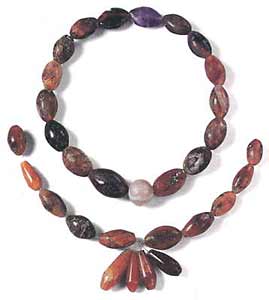
Fig. 10 Gold signet-rings with
engraved representation of scenes of battle and hunting from a
chariot. From Shaft Grave IV of Grave Circle A at Mycenae.
Late 16th century BC.
Athens, National Archaeological Museum, 241, 240.
|

Fig. 11 Gold
ring with a bezel in the form of a rosette and hoop with cloisonne
decoration. From the tholos tomb at Vapheio.
First half of 15th century BC.
Athens, National Archaeological Museum, 1804.

Fig. 13 Necklaces
of gold relief beads in the shape of ivy leaf and rosette. From the
Tholos Tomb at Dendra.
Late 15th century BC.
Athens, National Archaeological Museum, 7354, 7342.
|
|

Fig. 14 Necklace of
gold relief beads in the form of papyrus lily and of half rosette.
From Chamber Tomb 10 at Dendra.
End of 15th century BC.
Athens, National Archaeological Museum, 8748.
|

Fig. 15 Necklaces with
beads of agate, sard and amethyst in assorted shapes. From Chamber
Tombs 518 and 519 at Mycenae.
14th - 13th century BC.
Athens, National Archaeological Museum, 6521, 6435).
|
|
This period witnessed the rise and floruit of the great Greek
civilization that took its name from the famous citadel which was its most
important centre from beginning to end: 'gold-rich Mycenae'. From its heartland
in the Argolid. Mycenaean civilization spread to the Greek mainland and the
Aegean, attaining its zenith in the fourteenth and thirteenth centuries BC.
The abundant gold objects in the Shaft Graves at Mycenae validate Homer. Gold
seems to have had a special fascination for the Mycenaeans and goldsmithing held
a special place among the minor arts of Mycenaean Greece, with remarkable
achievements in jewellery-making. Nevertheless, like other arts, Mycenaean
goldsmithing drew liberally on the Minoan tradition.
The most impressive ornaments of the Early Mycenaean period come
from the Shaft Graves in the two Grave Circles at Mycenae. Some of these, such
as the famous gold masks, were intended for the adornment of the royal dead, but
the majority must have been worn in life by members of the royal families. For
the most pan these pieces are Mycenaean works, apart from the few purely Minoan
creations imported from Crete. Outstanding among the latter is the silver pin
with sheet-gold, cut-out head in the form of a female figure, presumably a
goddess, supporting papyrus branches in her outstretched arms (fig. 6). Many
ornaments were probably made to the instructions of Minoan craftsmen working in
Mycenaean workshops.
The jewellery from the two Grave Circles at Mycenae is
plentiful and splendid. Diadems of fine sheet gold (Fig. 5), some very large,
with repousse decoration. Gold cruciform cut-outs; various gold cut-outs in the
shape of animals, birds, octopuses, butterflies, leaves etc. (Fig. 8); gold
discs embossed or engraved with octopus, butterfly, geometric and other motifs
(Figs 7-8); all these were most probably seven onto luxurious garments. Pins of
gold, silver or bronze, with gold finial or spherical head of rock crystal,
ivory or gilded wood, worn on the chest, in the diadems or the hair. Large
lunate or heart-shaped earrings (Fig. 9).
Bracelets or armlets and heavy belts of a single sheet of gold
with repousse decoration. Gold signet-rings (Fig.l0). Gold strips delicately
engraved with geometric patterns that invested bone buttons. Necklace beads and
pendants in diverse shapes, mainly of gold and amber, as well as semi-precious
stones such as sard, amethyst and rock crystal. Many of the jewellery types from
the Grave Circles at Mycenae, such as necklaces, bracelets, earrings and pins,
are depicted in the wall-paintings from Akrotiri, Thera, that are dated to the
second half of the sixteenth century BC.
From the middle of the fifteenth century BC onwards, when
Mycenaean dominance was gradually established throughout the Aegean, the
principal types of ornaments were gold necklace relief beads and pendants, as
well as rings, Frequently of gold and more rarely of silver, bronze and lead.
The Mycenaeans also fashioned beads from semi-precious stones such as agate,
sard, amethyst, rock crystal and steatite (Fig.15), as well as from faience and
glass.
As time passed the last was used with increasing frequency,
not only because it was a cheaper material, but also because it is easier and
quicker to make beads by casting in stone moulds (Fig. 16). Gold beads and gold
ornaments (Figs 12-14) were made by hammering thin gold sheet in moulds and
completed with granulation, filigree and cloisonne technique inlaid with
semi-precious stones or glass.
A very large variety of beads of gold or semi-precious stones, faience and glass
is known - over 100 types of floral, marine and geometric shapes - enhanced with
grooves, ribs and granulation. Sometimes the beads of glass or faience were
invested with very fine old leaf. There are also several small steatite cones
that were most probably used as buttons.
The rings were usually simple gold hoops with elliptical
bezels, sometimes plain or, more often, with engraved designs comparable to
those on sealstones, for which reason these rings have been characterized as
signets belonging to officials Sometimes the ring bezels were embellished with
granulation or inlaid with enamel, semi-precious stones or glass (Fig. 11). Most
of the rings are hammered; very few are cast.
Among the jewellery of the closing years of the Mycenaean period
are the bronze fibulae. These first appeared in the thirteenth century BC and
are considered to be of Italian origin. Primarily used for fastening garments -
like the bronze pins of this period - fibulae are of two types, the fiddlebow
appearing earlier and the arched later.
|

